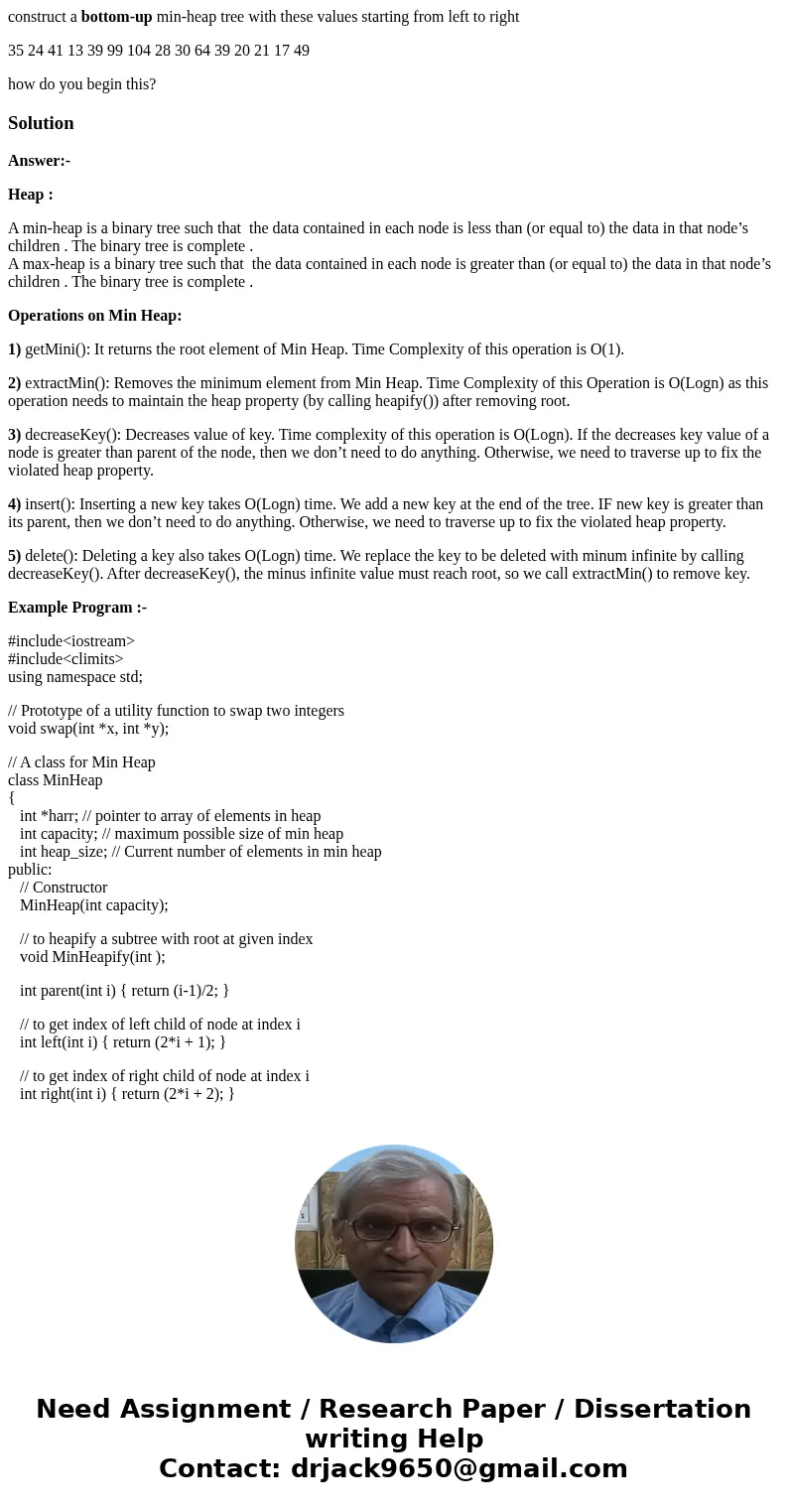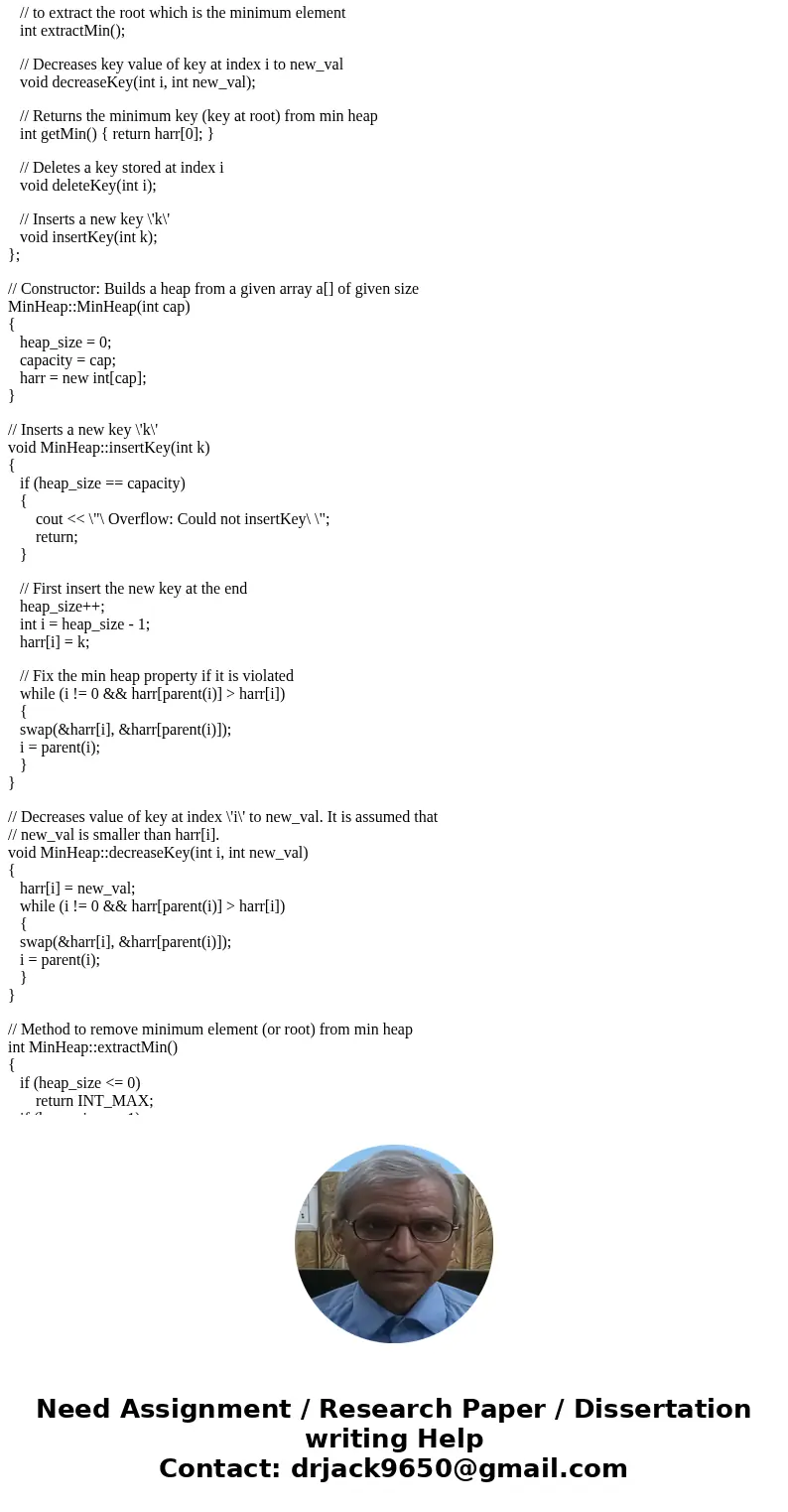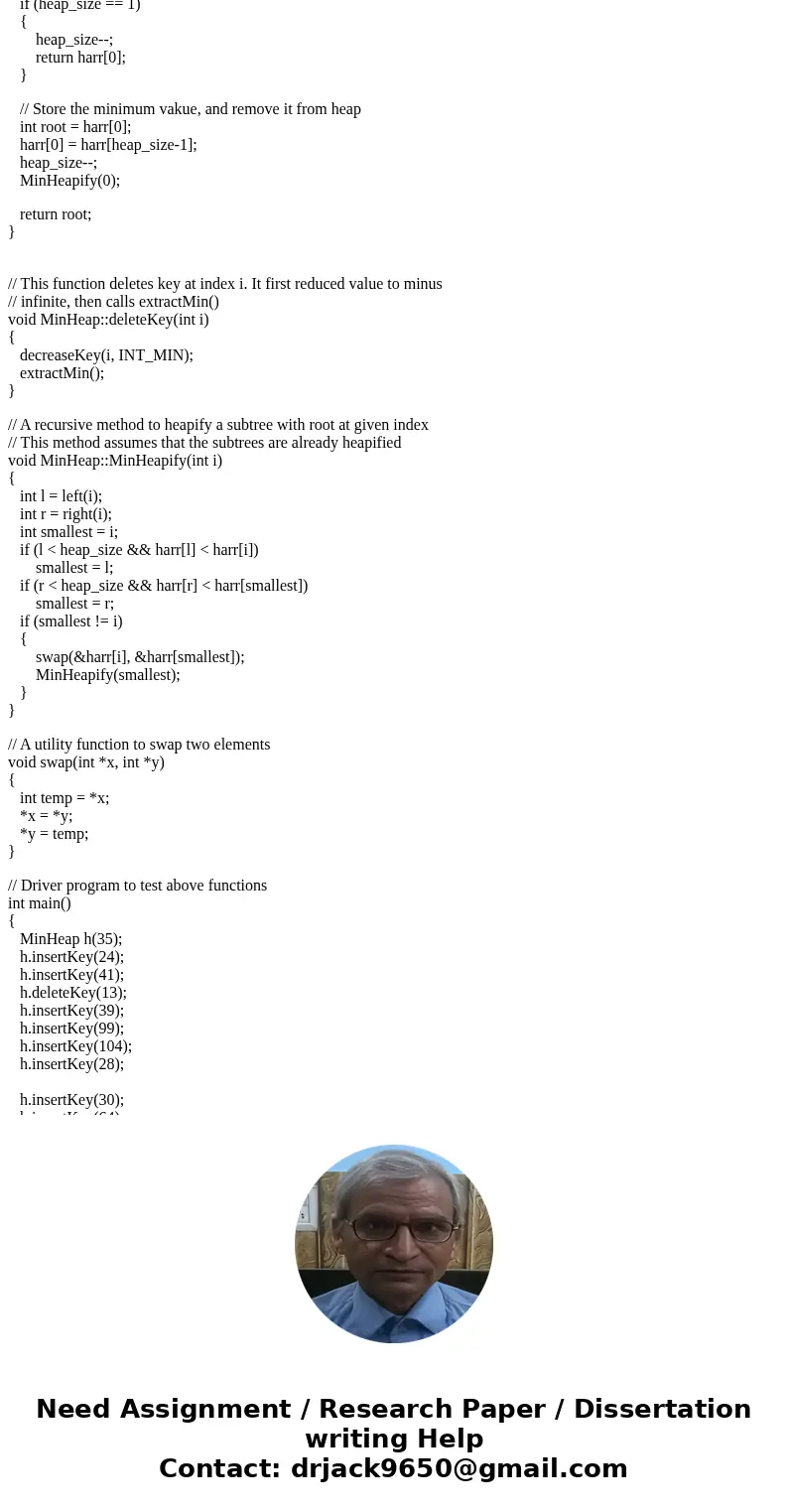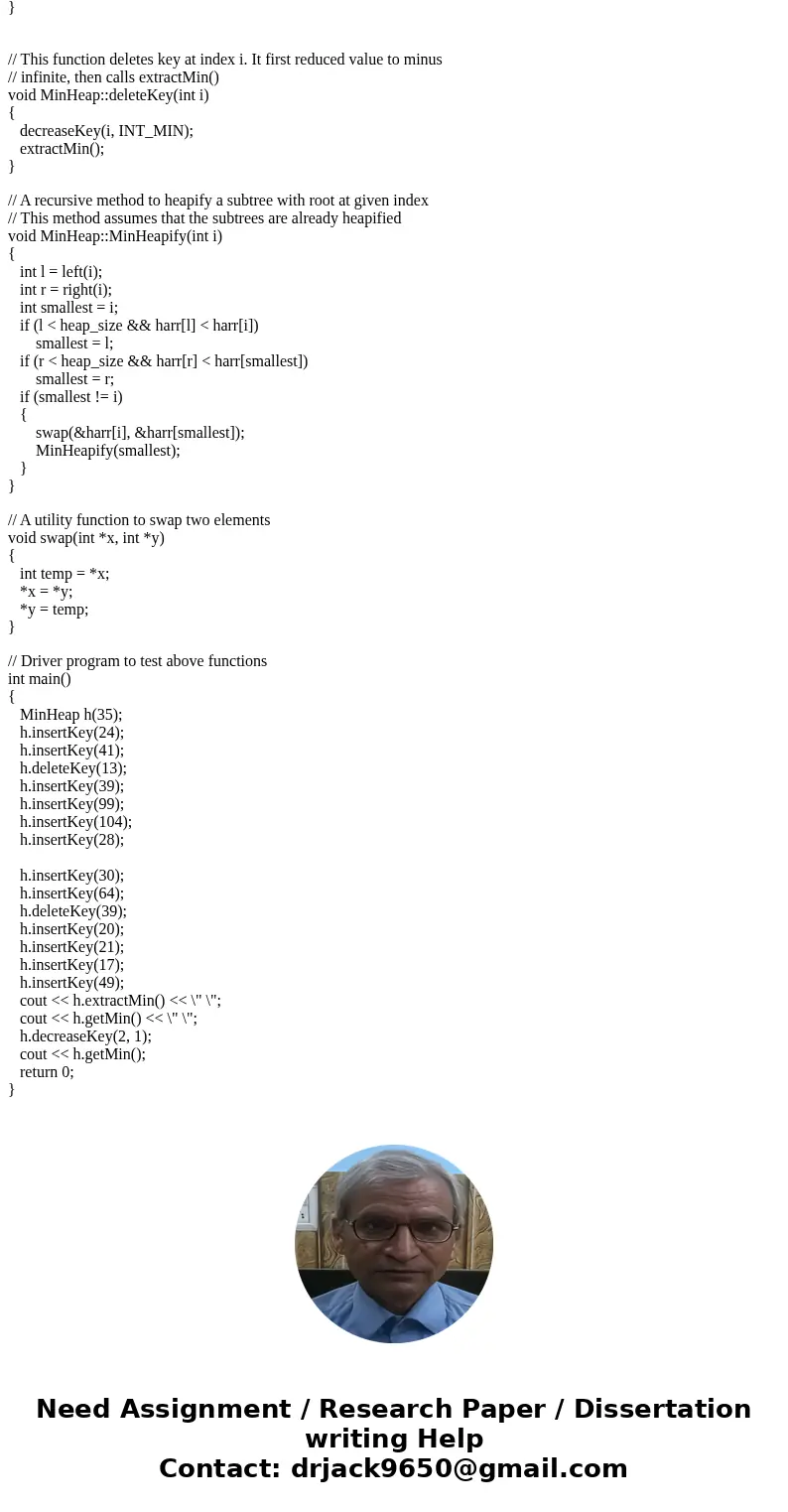construct a bottomup minheap tree with these values starting
construct a bottom-up min-heap tree with these values starting from left to right
35 24 41 13 39 99 104 28 30 64 39 20 21 17 49
how do you begin this?
Solution
Answer:-
Heap :
A min-heap is a binary tree such that the data contained in each node is less than (or equal to) the data in that node’s children . The binary tree is complete .
A max-heap is a binary tree such that the data contained in each node is greater than (or equal to) the data in that node’s children . The binary tree is complete .
Operations on Min Heap:
1) getMini(): It returns the root element of Min Heap. Time Complexity of this operation is O(1).
2) extractMin(): Removes the minimum element from Min Heap. Time Complexity of this Operation is O(Logn) as this operation needs to maintain the heap property (by calling heapify()) after removing root.
3) decreaseKey(): Decreases value of key. Time complexity of this operation is O(Logn). If the decreases key value of a node is greater than parent of the node, then we don’t need to do anything. Otherwise, we need to traverse up to fix the violated heap property.
4) insert(): Inserting a new key takes O(Logn) time. We add a new key at the end of the tree. IF new key is greater than its parent, then we don’t need to do anything. Otherwise, we need to traverse up to fix the violated heap property.
5) delete(): Deleting a key also takes O(Logn) time. We replace the key to be deleted with minum infinite by calling decreaseKey(). After decreaseKey(), the minus infinite value must reach root, so we call extractMin() to remove key.
Example Program :-
#include<iostream>
#include<climits>
using namespace std;
// Prototype of a utility function to swap two integers
void swap(int *x, int *y);
// A class for Min Heap
class MinHeap
{
int *harr; // pointer to array of elements in heap
int capacity; // maximum possible size of min heap
int heap_size; // Current number of elements in min heap
public:
// Constructor
MinHeap(int capacity);
// to heapify a subtree with root at given index
void MinHeapify(int );
int parent(int i) { return (i-1)/2; }
// to get index of left child of node at index i
int left(int i) { return (2*i + 1); }
// to get index of right child of node at index i
int right(int i) { return (2*i + 2); }
// to extract the root which is the minimum element
int extractMin();
// Decreases key value of key at index i to new_val
void decreaseKey(int i, int new_val);
// Returns the minimum key (key at root) from min heap
int getMin() { return harr[0]; }
// Deletes a key stored at index i
void deleteKey(int i);
// Inserts a new key \'k\'
void insertKey(int k);
};
// Constructor: Builds a heap from a given array a[] of given size
MinHeap::MinHeap(int cap)
{
heap_size = 0;
capacity = cap;
harr = new int[cap];
}
// Inserts a new key \'k\'
void MinHeap::insertKey(int k)
{
if (heap_size == capacity)
{
cout << \"\ Overflow: Could not insertKey\ \";
return;
}
// First insert the new key at the end
heap_size++;
int i = heap_size - 1;
harr[i] = k;
// Fix the min heap property if it is violated
while (i != 0 && harr[parent(i)] > harr[i])
{
swap(&harr[i], &harr[parent(i)]);
i = parent(i);
}
}
// Decreases value of key at index \'i\' to new_val. It is assumed that
// new_val is smaller than harr[i].
void MinHeap::decreaseKey(int i, int new_val)
{
harr[i] = new_val;
while (i != 0 && harr[parent(i)] > harr[i])
{
swap(&harr[i], &harr[parent(i)]);
i = parent(i);
}
}
// Method to remove minimum element (or root) from min heap
int MinHeap::extractMin()
{
if (heap_size <= 0)
return INT_MAX;
if (heap_size == 1)
{
heap_size--;
return harr[0];
}
// Store the minimum vakue, and remove it from heap
int root = harr[0];
harr[0] = harr[heap_size-1];
heap_size--;
MinHeapify(0);
return root;
}
// This function deletes key at index i. It first reduced value to minus
// infinite, then calls extractMin()
void MinHeap::deleteKey(int i)
{
decreaseKey(i, INT_MIN);
extractMin();
}
// A recursive method to heapify a subtree with root at given index
// This method assumes that the subtrees are already heapified
void MinHeap::MinHeapify(int i)
{
int l = left(i);
int r = right(i);
int smallest = i;
if (l < heap_size && harr[l] < harr[i])
smallest = l;
if (r < heap_size && harr[r] < harr[smallest])
smallest = r;
if (smallest != i)
{
swap(&harr[i], &harr[smallest]);
MinHeapify(smallest);
}
}
// A utility function to swap two elements
void swap(int *x, int *y)
{
int temp = *x;
*x = *y;
*y = temp;
}
// Driver program to test above functions
int main()
{
MinHeap h(35);
h.insertKey(24);
h.insertKey(41);
h.deleteKey(13);
h.insertKey(39);
h.insertKey(99);
h.insertKey(104);
h.insertKey(28);
h.insertKey(30);
h.insertKey(64);
h.deleteKey(39);
h.insertKey(20);
h.insertKey(21);
h.insertKey(17);
h.insertKey(49);
cout << h.extractMin() << \" \";
cout << h.getMin() << \" \";
h.decreaseKey(2, 1);
cout << h.getMin();
return 0;
}




 Homework Sourse
Homework Sourse